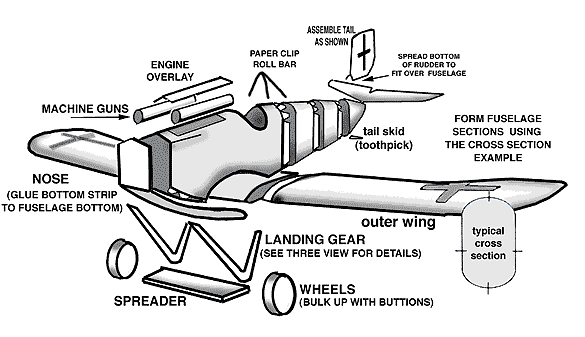
Junkers D-1 German WWI Scout
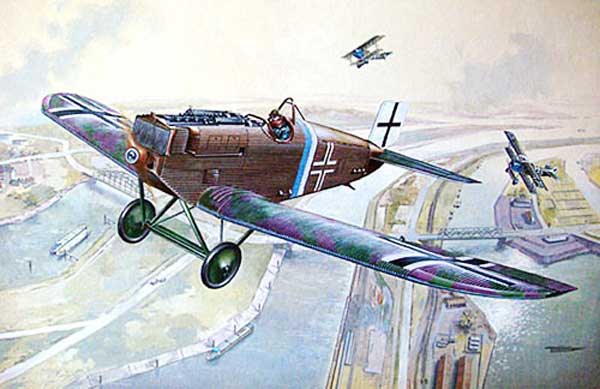
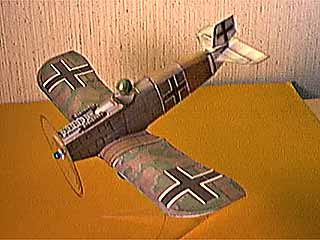
The Junkers D1 certainly was a giant step in aeronautical engineering with it's all metal full cantilevered wings. So advanced was it that the workers struggled to produce it in any numbers not having experience working with corrugated metal. Estimates put it about 15 years before it's time.
The Army ordered it built as the D1. Armament consisted of a pair of fixed, forward-firing Spandau guns ahead of the cockpit...
Junkers D-1 and J10
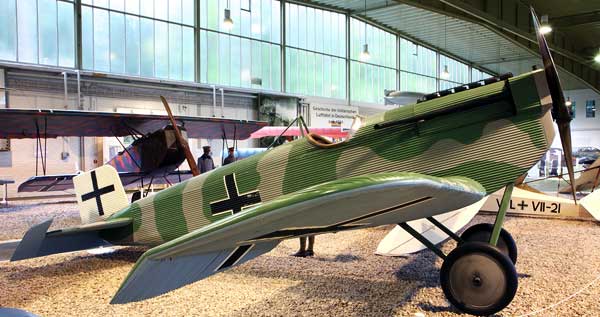
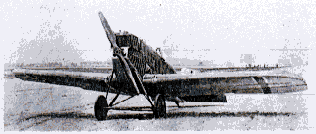 THE FIRST JUNKERS factory design was the J 1 (Army designation
El); it was known as The Tin Donkey, and only one was built. The
9th Junkers design, the J 9, appeared in October 1917, and with
its 160 hp Mercedes was entered in the fighter competitions of
1918. The Army ordered it built as the Dl. Armament consisted
of a pair of fixed, forward-firing Spandau guns ahead of the cockpit.
THE FIRST JUNKERS factory design was the J 1 (Army designation
El); it was known as The Tin Donkey, and only one was built. The
9th Junkers design, the J 9, appeared in October 1917, and with
its 160 hp Mercedes was entered in the fighter competitions of
1918. The Army ordered it built as the Dl. Armament consisted
of a pair of fixed, forward-firing Spandau guns ahead of the cockpit.
Because of lack of experience with the aircraft's then-unconventional metal construction, only forty-one D. Is were completed and delivered to the Front before the Armistice in November 1918. The aircraft featured a number of unique innovations, one of which was a full cantilever wing.
|
Doc Rowland, Midland TX, sends us this photo of his Junkers low wing monoplane along with this little blurb.... Stand is varnishedbasswood from local crafts store, snow is baking powder, dog and windsock, as well as 'chute pack are cobbled together out of the scrap box, and a "tarp" is short for "Tarpaulin"...canvas cover for cockpits, engines, the pilot, whatever. Look closely and you'll see it just aft of the cockpit. Look closely at the tail surfaces for the characteristic Junkers'"crimps" at the edges. More to Come...Oh yes, LOTS more!
|
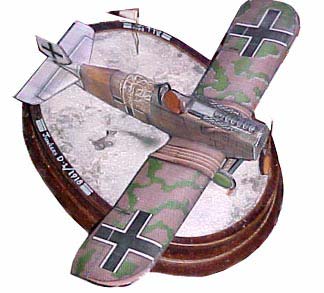 |
Junkers J 10 (CL I)
Virtually a two-seat version of the I) 1, the CL I was put into production during the later half of 1918 with the intention of replacing the Halberstadt CL types. Again an all- metal machine, continuing the usual style of Junkers construction with corrugated dural covering, some forty-seven aircraft had been built by the end of the war. The prototype is illustrated.
JUNKERS D-1
The world's first all-metal aeroplane, the Junkers J. was completed in 1915 under the direction of Professor Hugo Junkers. Its structure consisted of ribbed metal I sheeting with internal tubular bracing.
Installed in the pointed nose was a 120 h.p. Mercedes engine, fitted with a 'chimney'-type exhaust pipe, and an interesting innovation-an under slung radiator. The wings were thick in section, with sharply cut tips and aileron' which extended behind the line of the trailing-edge. The fuselage was square in section. The tail and balanced rudder had square edges, and the whole appearance of the aircraft was strong but crude. Nicknamed the 'Blechesel' (Tin Donkey), the D-1 was, quite naturally, regarded with suspicion by the authorities.
In 1916 a development of the J-1, the J.2. was constructed; a single-seater fighter monoplane with remarkably modern lines. A deep under slung radiator was provided for its 160 h.p. Mercedes engine and a crash pylon was fixed behind the cockpit to protect the pilot in the event of the plane turning over. A single Spandau gun was synchronized to fire through the revolving airscrew. The J.2 was given the military designation of E-II, but only six examples. E250-255. were built.
Although Professor Junkers had achieved only partial success with his designs, officialdom was impressed with their strength, and persuaded him to work with Anthony Fokker on the design of a new armored two-seater biplane intended for army co-operation duty. The new model, the J.4 (military designation J-I), proved to be most useful, but relations between the partners were never happy.
The next Junkers fighter design was the J.7, another all-metal monoplane, which made its appearance in October 1917. In its early form, the nose installation of its 160 h.p. Mercedes engine was fairly well streamlined and the airscrew had a small spinner. A clumsy exhaust pipe stretched down the starboard side of the fuselage. Almost as an afterthought, a radiator was fixed inconveniently above the cylinders. Wing construction consisted of ribbed aluminum, braced internally by seven parallel tubular metal spars interconnected to form Warren girders.
Oddly shaped unequal-chord ailerons replaced the original rotating wingtips. The fuselage was covered with horizontally corrugated metal strips. Both elevators and rudder were balanced. A high head-rest behind the cockpit acted as a crash pylon. A second 17 had a neat under slung radiator, modified undercarriage and a blunt nose without a spinner; the headrest was reduced to skeleton form. A third version, equipped with a car-type radiator, was an excellent aeroplane and would have performed with success at the Adlershof fighter competition in January 1918. Unfortunately, only four weeks before the contest it sustained damage, when flown by Fokker himself.
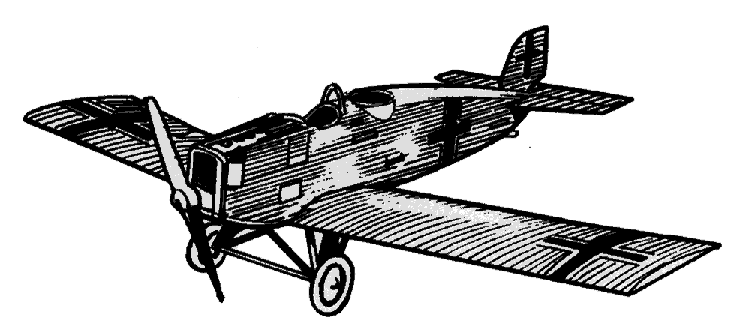
A further development, the 3.9 (military designation D-I), was brought out in March 1918. It was flown with both the 150 h.p. Mercedes and 185 h.p. BMW engines. and carried twin Spandau guns. The D-1 was speedy and maneuverable but was more difficult to build than the useful Fokker D-VII, which was already in production. Only forty-one examples reached the front; these were issued in ones and twos to various Jagdstaffeln.
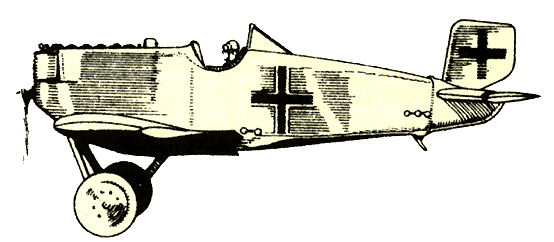
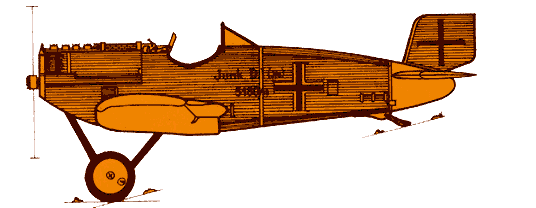
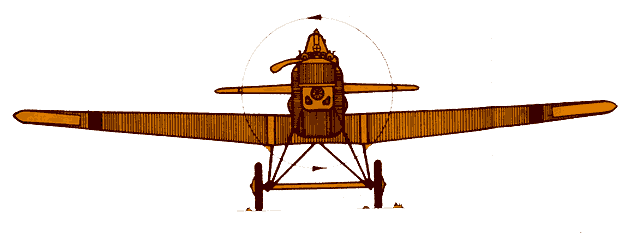
Specifications for the Junkers D-1
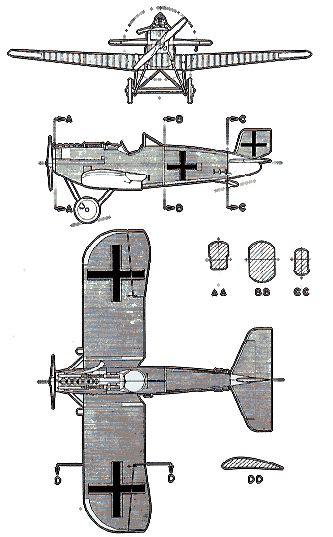 |
Length: 23 ft Wing Span: 29.5 ft Wing Area: 159 sq ft Powerplant: 1x Mercedes D.IIIa Engine 160 hp Performance Maximum Speed: 109 mph Rate of Climb to 16,404 9 minutes 30 sec Armament 2xLMG08/15 Spandau |



